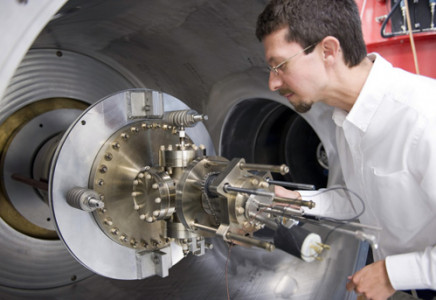
Inspecting an injector assembly at Jefferson Lab's LERF
Jefferson Lab’s Low Energy Recirculator Facility, formerly known as the Free-Electron Laser, was developed using the lab’s expertise in superconducting radiofrequency (SRF) accelerators. As an FEL, the facility was the world’s highest-power tunable infrared laser and also provided ultraviolet laser light, including vacuum ultraviolet light, and Terahertz light. Currently, the lab is using the term Low Energy Recirculator Facility, or LERF, to refer to this facility, as future missions with potentially broader scope are under development.
The uniqueness of Jefferson Lab’s LERF stems from what it does with the electrons. It generates the electrons’ energy and then recovers it using a superconducting energy-recovering linac, or ERL. In the ERL, the electron beam is re-cycled back through the accelerator out of phase with the accelerating field, so that the beam energy generated in its first trip through the accelerator is returned to the SRF cavities. This power, which would normally be dumped, can represent 90 percent of the beam power in a high-power linear accelerator. While the Jefferson Lab facility remains the highest-power ERL system in existence, a number of other laboratories are adopting this technology.
Many of the future uses envisioned for the LERF use its underlying ERL. The present range of discussion includes future nuclear physics experiments, characterization of materials using low-energy positrons, and R&D on production of medical isotopes. There is also substantial potential for facilitation of commercial development of free-electron laser technology, and Jefferson Lab is pursuing this option, as well. The lab is developing a plan for future utilization of this facility in a manner that is of maximum benefit to the mission of the laboratory and of the nation.

